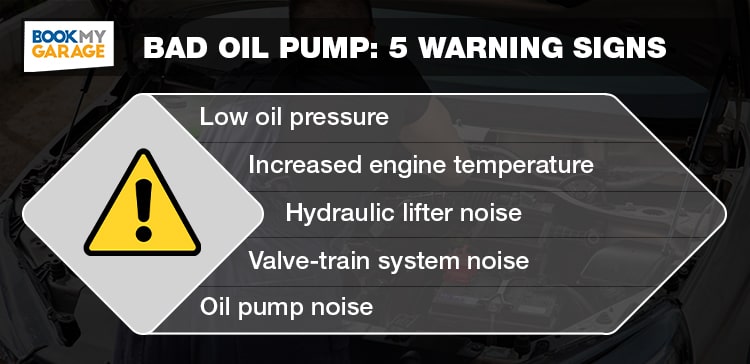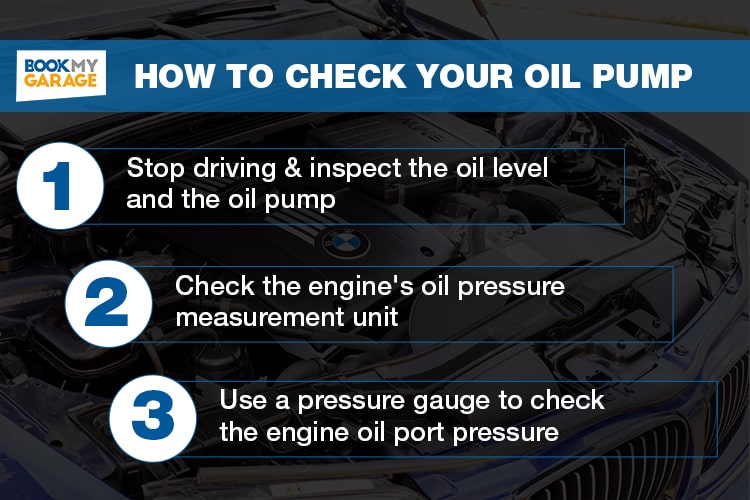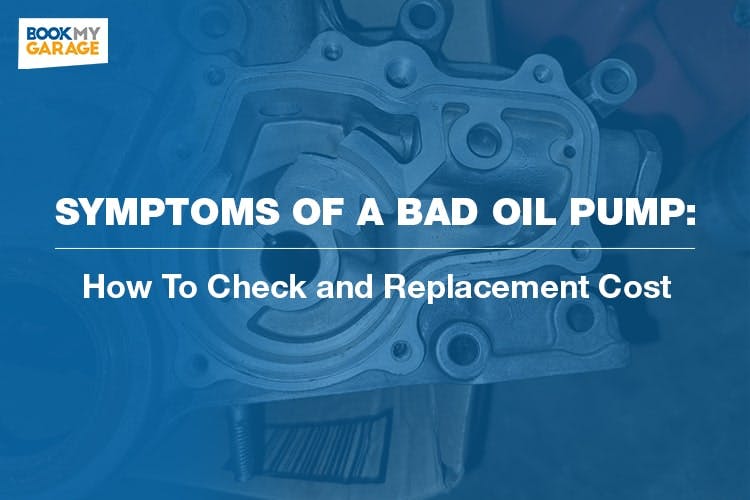A bad oil pump can do damage to your car’s engine and limit your vehicle’s overall performance.
That’s why it is so important that you know the symptoms of a bad oil pump to look out for.
Delaying repairs can lead to engine failure and cost you more money in the long run, so it pays to be proactive when it comes to oil pump failure.
Read on and find out the 5 main symptoms of a bad oil pump, how to check it, and whether or not you can drive with a bad oil pump.
Page Contents
Symptoms of a Bad Oil Pump

If you notice any of the following symptoms, you should book an appointment with a local garage immediately as your vehicle may be suffering from a bad oil pump.
Low Oil Pressure
The oil pump is responsible for providing and regulating the oil that lubricates the engine, as well as for controlling its temperature
It does this by facilitating the distribution of oil throughout the various engine components.
As a result, the engine’s moving parts will easily slide against each other without any risk of damage because they are properly greased.
Oil leaks can occur if the lubricating system is damaged by the pressure produced by the oil pump.
Without sufficient oil pressure, the oil won’t be able to travel through the lubricating system and into the machine parts to lubricate them.
Low oil pressure resulting from a bad oil pump will cause the moving parts of your vehicle’s engine to rub roughly against each other.
You may notice an illuminated engine oil pressure warning light on the dashboard if the oil pressure is low.
Increased Engine Temperature
Inadequate oil in the engine resulting from a defective oil pump will cause it to run dry.
This means that its components won’t have the required lubrication to move freely – meaning more friction, and more heat being generated.
This will cause an increase in engine temperature, which can damage the engine and its components.
If the engine is properly lubricated, the oil will absorb the excessive heat that the engine generates whilst dissipating it as it moves around the engine.
Hydraulic Lifter Noise
The hydraulic lifter is a major component of the engine’s valve-train operations, as it helps to maintain valve clearance.
It needs a lot of lubrication to work properly – oil won’t reach the hydraulic lifters if there is low oil pressure stemming from a malfunctioning oil pump.
As a result, the hydraulic lifter won’t be able to move properly, creating a lot of noise as it tries to do so – likely a tapping or clicking sound.
A lack of lubrication in the hydraulic lifter will cause wear and tear due to friction, thereby shortening its lifespan.
Valve-train System Noise
A vehicle’s valve-train system consists of key parts such as seals, pushrods and valve guides.
These components need proper lubrication for the metal parts.
Poor lubrication caused by a bad oil pump will lead to excessive friction in the mechanical parts – and a tapping or clattering noise being produced in the valve-train system as a result.
Oil Pump Noise
When it is working normally, the oil pump will operate silently.
However, if the oil pump is faulty, it can produce a whining sound as it tries to distribute oil around the engine.
This sound is likely due to the wearing out of the oil pump gears and will be most noticeable when the vehicle is idling.
Please note that a whining noise could also be attributed to a failing alternator or power steering pump.
A mechanic will be able to advise you further if you aren't certain which part is causing the noise.
You should quit oil pump operations if you hear any of these noises and inspect your lubrication system accordingly.
How to Check Your Oil Pump

Now that you know the dangers a faulty oil pump poses to your vehicle’s engine, you can learn how to check – or test – your oil pump for any failures.
You can then replace it if you notice any symptoms.
Step 1: Stop Driving
If you are driving and notice that the low oil light on your car’s dashboard is illuminated, you must stop the car and use a dipstick to check the oil levels.
You can add more engine oil if the oil level is low.
Start the car and look out for any symptoms of a malfunctioning oil pump.
Step 2: Check the Engine's Oil Pressure Measurement Unit
If the low oil pressure light is still triggered after you refill the engine oil, then there may be a problem with the vehicle’s measurement communication system – often caused by a faulty sensor or wiring.
However, if you don’t have any electrical issues with your vehicle and notice strange noises coming from your car after topping up the oil, you should check the oil pressure of the car.
Step 3: Use a Pressure Gauge to Check the Engine Oil Port Pressure
If the low oil pressure light won’t turn off even after addressing these aforementioned issues, then you likely have a bad oil pump.
You now need to put an oil pressure gauge on the oil port of the engine.
Next, check the oil pressure readings and compare them with your vehicle’s recommended oil pressure to see if there are any differences.
If the readings come out normal, chances are you have a problematic sending unit.
However, if the readings show that you have low oil pressure, you should clean the oil filter and proceed to test the pump once more.
If oil pressure is still unusually low after testing and cleaning the filter, the oil pump may be failing or the engine may be wearing out.
If you are stuck by the side of the road and can’t complete this test yourself, you should call your recovery provider.
They will have the equipment on hand to test whether your oil pump is faulty.
If the issue persists, you should book an appointment with a local garage to have the problem resolved.
How Much Does an Oil Pump Repair Cost?
An oil pump repair can cost between £500 and £1,000 on average in the UK – with more complex replacements even exceeding this price.*
*Based on data taken from Bumper
Can I Carry Out an Oil Pump Replacement Myself?
Replacing an oil pump should only be done by an experienced mechanic with the right tools and space to complete the job.
Do I Need to Book an Oil Change?
An oil and filter change does not directly involve servicing the oil pump.
However, ensuring regular oil changes can indirectly help to maintain the overall health of the oil pump by providing clean oil that reduces the likelihood of contaminants.
Dirty or contaminated oil can negatively impact engine components like the bearings and hydraulic lifters - clean oil can help to prevent engine lubrication system damage.
During an oil change, a mechanic will drain and refill your engine oil and replace the dirty filter.
Can You Drive With a Bad Oil Pump?
Whilst you can technically drive with a bad oil pump, doing so - even for a short distance - can lead to engine damage due to a lack of lubrication.
Driving with a bad oil pump can cause engine overheating and other components like the timing chain and gears to wear out prematurely.
If you notice any signs of oil pump failure, like low oil pressure or strange engine noises, you should stop driving right away.
Check your oil levels and call your recovery provider to assist you.
If you're experiencing issues with your oil pump, you should book in with a local garage.
A professional mechanic will be able to inspect your vehicle and replace the pump if needed.
FAQs








24 replies to "Top 5 Symptoms of a Bad Oil Pump: How to Check & Replacement Cost"
Seyi
November 20th, 2023
Eve McPherson
November 21st, 2023
Danny
March 4th, 2023
Drew Hickman
March 6th, 2023
Hamza Usman
July 12th, 2023
Eve McPherson
July 13th, 2023
Denise
September 25th, 2023
Eve McPherson
September 25th, 2023
Don Wright
January 15th, 2023
Drew Hickman
January 16th, 2023
Kingsley
January 2nd, 2023
Drew Hickman
January 3rd, 2023
Ron
April 7th, 2023
Eve McPherson
April 12th, 2023
John toft
October 15th, 2023
Eve McPherson
October 16th, 2023
Tim
November 4th, 2023
Eve McPherson
November 6th, 2023
Sarah
March 8th, 2024
Eve McPherson
March 11th, 2024
Vladimir
March 16th, 2024
Eve McPherson
March 25th, 2024
Darryl
May 25th, 2024
Eve McPherson
May 29th, 2024
Leave a comment